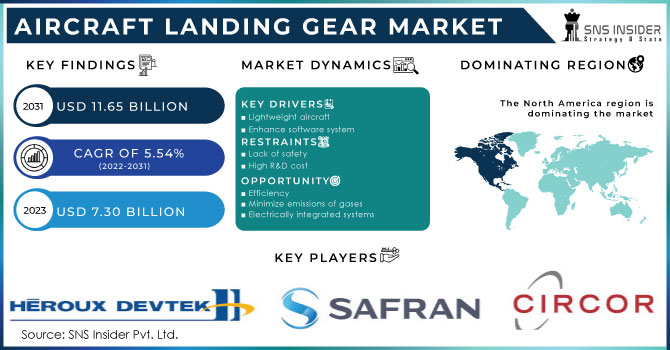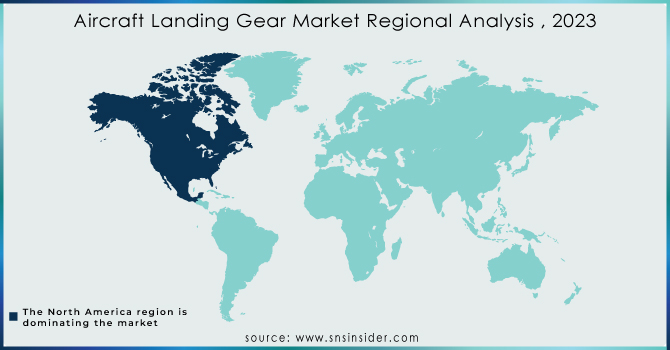Aircraft Landing Gear Market Report Scope & Overview:
The Aircraft Landing Gear Market Size was valued at USD 7.30 Billion in 2023 and is expected to reach USD 11.65 Billion by 2032 and grow at a CAGR of 5.54% over the forecast period 2024-2032.

To get more information on Aircraft Landing Gear Market - Request Free Sample Report
The spacecraft, a spacecraft with the power to carry the entire weight of the aircraft during takeoff and landing, is known as a landing gear. In order to maintain the desired maximum balance between the payload associated with each aircraft and the aircraft list, weight loss is a significant factor that has allowed the need for more technologically advanced gears to achieve fuel efficiency. Advances in technology and R&D systems associated with the supplement market, such as the steering system, actuation system and brake system, have begun to grow the market.
Drivers considered in this report the growth of the aviation industry and the aviation industry, as well as the need for simpler seating gear. In addition, the need for efficient fuel economy and improved commercial aviation are some of the challenges facing the market. Landing gear for a variety of commercial airlines includes a small / single aircraft, medium-sized aircraft, large aircraft, and regional jets. Increasing market share for small, one-way, low-cost airlines, provided by low-cost airlines, is expected to have a positive impact on market growth. Regional jets are expected to have a high growth rate due to the increased number of short-distance travel between countries such as the U.S. and Canada. EMEA is showing a significant growth rate due to the rapid growth of the aviation industry in the region, which will support the growth of the Aircraft Landing Gear market.
MARKET DYNAMICS
KEY DRIVERS
-
Lightweight aircraft
-
Enhance software system
-
Efficiency and sustainability
RESTRAINTS
-
Lack of safety
-
High R&D cost
OPPORTUNITIES
-
Efficiency
-
Minimize emissions of gases
-
Electrically integrated systems
CHALLENGES
- Manufacturing
- Designing
- Precise tolerance
THE IMPACT OF COVID-19
The COVID-19 epidemic affected globalization by 2020 by reducing the need for air travel, reducing air traffic, and contributing to the financial crisis. The decline in aviation in 2020 has led to a decline in interest in MRO residential gear.
Then, a few carriers have approved their business flight plans. Large-scale construction and OEM aircraft are relied upon to generate interest in the production of seating gear in a limited time.
Aircraft manufacturers focus more on weight loss as it improves environmental performance and increases carrier benefits. Coincidentally, there is a growing interest in the framework of lightweight immigration gear, forcing manufacturers to embrace new developments and building materials to encourage new gear congregations.
At the same time, with the improved adoption of electrical components in the aircraft, OEMs' critical residential gear replaces pressure-sensitive structures with improved electrical performance while reducing weight.
By Aircraft Type
Based on the type of aircraft, the fixed-wing component is expected to grow with the highest CAGR value in the aircraft gear market during the forecast period. The fixed-wing segment is expected to have significant growth due to the growing number of commercial airlines delivering and the increase in orders for commercial airlines and general airlines. Wing-wing aircraft also see an increase due to increased orders for fighter jets and UAVs due to increased border crossings, particularly in the Middle East and Asia Pacific Region.
By Type
The main Aircraft Landing Gear is expected to grow to the largest, based on the type of seating gear. Increasing aircraft delivery and technological advances such as the need for less weight, less volume, higher performance, and improved life of permanent gear systems are expected to further the aircraft gear market.
By End User
Based on end user, the rear market segment is expected to grow with the highest CAGR value in the aircraft gear market during the forecast period. The need for maintenance services, repairs, and timely repairs especially replacement parts and systems, and the fact that new MRO facilities are opening are some of the reasons why the rear market segment has seen growth.
By Sub-Framework
Based on a small system, part of the actuation system is expected to be the highest level of CAGR in the aircraft gear market during forecasting. The growth of part of the actuation system may be due to various technological advances in high efficiency, high tolerance, and robust gear systems that are expected to boost the small system market. Modern aircraft systems such as UAVs, hybrid VTOLs, and AAMs are also expected to expand the market.
KEY MARKET SEGMENTATION
By Aircraft Type
-
Fixed Wing
-
Rotary Wing
By Type
-
Main Landing Gear
-
Nose Landing Gear
By End User
-
OEM
-
Aftermarket
By Sub-Framework
-
Actuation System
-
Steering System
-
Others
REGIONAL ANALYSIS
Aircraft Landing Gear Market Trends include During the specified time frame, North America is expected to hold the most significant percentage of the overall aviation industry. The increase in airplane orders and supplies in North America enables makers of aviation landing pinion wheels to develop their business year after year.
The growing enthusiasm for business Aeroplanes, as well as the presence of some of the major companies on the lookout, for example, Collins Aerospace, Triumph bunch, Parker Hannifin, and Crane Co., are expected to boost the Commercial Aircraft Landing Gear market in North America. These companies are included in the Commercial Aircraft Landing Gear Market Forecast to expand their product offerings and use mechanically advanced frameworks, subsystems, and various parts. to assemble airplane landing gears.

Need any customization research on Aircraft Landing Gear Market - Enquiry Now
REGIONAL COVERAGE
-
North America
-
USA
-
Canada
-
Mexico
-
-
Europe
-
Germany
-
UK
-
France
-
Italy
-
Spain
-
The Netherlands
-
Rest of Europe
-
-
Asia-Pacific
-
Japan
-
south Korea
-
China
-
India
-
Australia
-
Rest of Asia-Pacific
-
-
The Middle East & Africa
-
Israel
-
UAE
-
South Africa
-
Rest of Middle East & Africa
-
-
Latin America
-
Brazil
-
Argentina
-
Rest of Latin America
-
KEY PLAYERS
The Major Players are CIRCOR Aerospace, Safran SA, Heroux-Devtek, Messier-Bugatti-Dowty, UTC Corporation, Liebherr Group, Raytheon Technologies Corporation, Honeywell International Inc., AAR Corporation, Meggitt PLC, and other players.
| Report Attributes | Details |
|---|---|
| Market Size in 2023 | US$ 7.30 Billion |
| Market Size by 2032 | US$ 11.65 Billion |
| CAGR | CAGR of 5.54% From 2024 to 2032 |
| Base Year | 2023 |
| Forecast Period | 2024-2032 |
| Historical Data | 2020-2022 |
| Report Scope & Coverage | Market Size, Segments Analysis, Competitive Landscape, Regional Analysis, DROC & SWOT Analysis, Forecast Outlook |
| Key Segments | • By Aircraft Type (Fixed Wing, Rotary Wing) • By Type (Main Landing Gear, Nose Landing Gear) • By End User (OEM, Aftermarket) • By Sub-Framework (Actuation System, Steering System, Brake System, Others) |
| Regional Analysis/Coverage | North America (USA, Canada, Mexico), Europe (Germany, UK, France, Italy, Spain, Netherlands, Rest of Europe), Asia-Pacific (Japan, South Korea, China, India, Australia, Rest of Asia-Pacific), The Middle East & Africa (Israel, UAE, South Africa, Rest of Middle East & Africa), Latin America (Brazil, Argentina, Rest of Latin America) |
| Company Profiles | CIRCOR Aerospace, Safran SA, Heroux-Devtek, Messier-Bugatti-Dowty, UTC Corporation, Liebherr Group, Raytheon Technologies Corporation, Honeywell International Inc., AAR Corporation, Meggitt PLC, and other players. |
| DRIVERS | • Lightweight aircraft • Enhance software system • Efficiency and sustainability |
| RESTRAINTS | • Lack of safety • High R&D cost |

